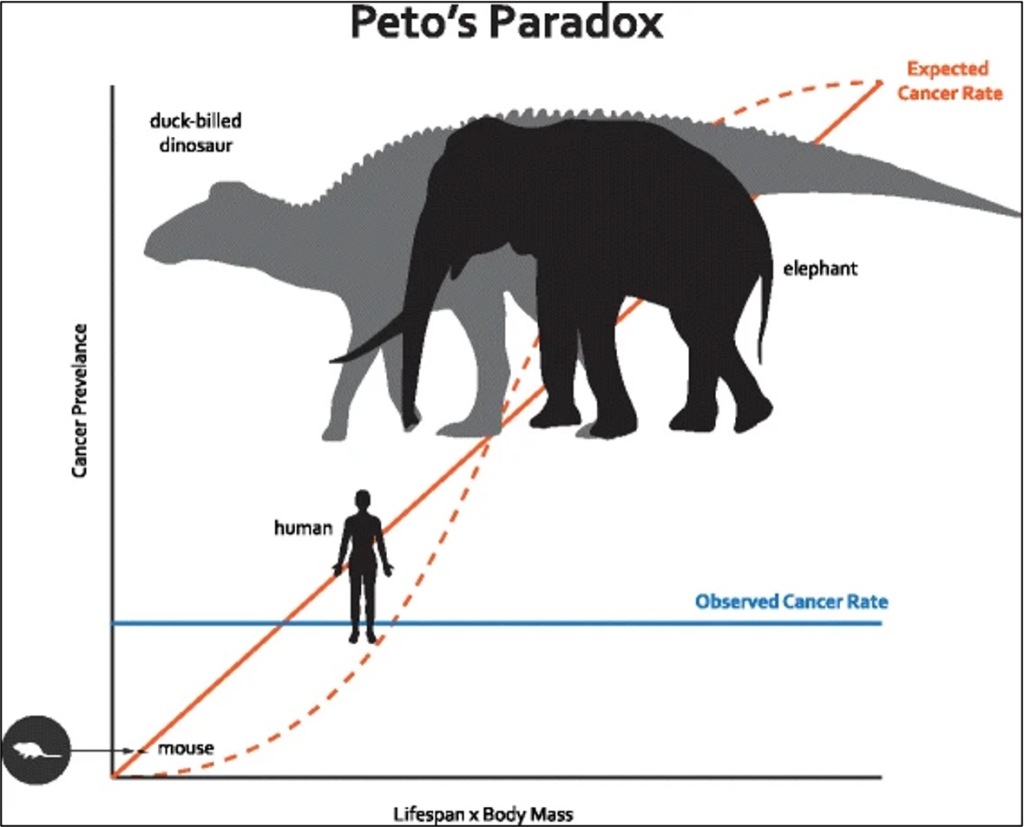Why don’t elephants get cancer?
You can watch this episode on our new YouTube channel here!
Elephants are the subject of many flattering similes about strength, courage, and memory. Perhaps we have been complimenting the wrong attributes all along. In this episode of The Curious Clinicians, we will be exploring a lesser-known asset of everyone’s favorite tusked mammal (sorry, walruses). Why are cancer rates in elephants lower than those of many mammals, including humans?
This question is interesting because it seems to go against basic probability. The African Bush Elephant is the largest land mammal in the world, with adult males weighing as much as 6,000kg. Between similar species, cell size varies much less than body size, which implies that elephants must have many more cells than humans. Elephants also live for longer than most mammals. Shouldn’t more cells + more time = more opportunity to develop cancer? This counter-intuitive observation is known as “Peto’s Paradox,” named after British epidemiologist Richard Peto. In the 1970’s, Peto published a now-classic paper in which he noted that although humans are much bigger than mice and live ~30x longer, cancer rates don’t differ appreciably between them.

Cancer statistics are much harder to measure in elephants than they are in humans (there’s no dedicated cancer ward on the Serengeti where elephants know to go). From databases and autopsies of zoo elephants, the best estimate is that the cancer mortality rate of elephants is 4.8%. For comparison, most mammals have a rate of ~20% (although the Tasmanian devil has a rate of ~50%!), and humans range from 10-25%. So, what is protecting elephants against cancer? If you’ve ever taken a cell biology or genetics course, you know what the answer is: p53, the so-called “guardian of the genome.”
Cancer requires several things to develop: Genetic instability (which increases frequency of mutations), and then subsequent apoptosis (programmed cell death) evasion. These qualities feed off each other as continued growth helps accumulate mutations that then allow for more growth. Cells are primed for cancer through mutations in either tumor-suppressor genes (those which halt the cell cycle) or proto-oncogenes (which encourage cell growth). TP53, the gene that produces the p53 protein, is the most commonly mutated gene in cancer, present in 39% of all malignancies.

In healthy cells, p53 acts as a brake on the cell cycle through its interactions with another protein, MDM2. When cellular conditions are good, MDM2 attaches to p53, and the cell continues to divide. During periods of cellular stress and DNA damage, p53 is freed and helps activate genes that halt the cell from dividing. When TP53 itself becomes mutated or inhibited, such as by a virus or a rogue cellular protein, the cell is at high risk for unchecked growth. It’s no surprise then that Li-Fraumeni syndrome, in which people are born with mutations in TP53, has a lifetime cancer risk of around 80%.

Elephants appear to be blessed with the opposite problem. Two separate research groups in 2015 and 2016 discovered that elephants have 20 copies of TP53. More precisely, they have one copy near-identical to humans and another 19 “retro-genes,” which arise when mRNA from the original gene undergoes retro-transcription to form a new one. The p53 produced by these retro-genes is less easily inhibited by MDM2, and helps the elephant cell be more sensitive to DNA damage. In one 2015 study, elephant and human lymphocytes were exposed to ionizing radiation, a potent carcinogen. The elephant cells underwent apoptosis at a higher rate than the human ones, implying their intrinsic anti-cancer mechanisms were stronger.

One of the groups that discovered the multiple TP53 copies of the elephant genome also mapped out their chronology. The original TP53 arose ~64 million years ago, and then as the number of retro-gene copies started increasing ~40 million years ago, so did elephant ancestor size. This raises a question: Did elephants accumulate copies of TP53 as they got bigger, or did they get bigger because of the extra copies?

One also wonders, then, whether other large animals have also developed anti-cancer mechanisms. The humpback whale has ~ 1000x more cells than a human and can live to be 200 years old. Its genome contains numerous copies of tumor suppressors and other regulatory genes, which also accrued through time as whale ancestors grew. So why doesn’t every species accumulate more P53 and grow to be a cancer-resistant juggernaut? For some, it may be counter-adaptive; in mouse models, increasing TP53 expression leads to poor growth and fertility. In fact, the naked mole rat has some of the lowest cancer rates among mammals despite its diminutive stature. In others, it may just be that cancers tend to arise late in adulthood and, therefore, aren’t selected against.
Take Home Points
- Elephants have a lower rate of cancers than would be expected for their size and longevity
- p53 is a tumor suppressor protein encoded by TP53 gene which helps promote apoptosis or pause the cell cycle in response to cell stress & DNA damage
- Elephants have a high number of copies of p53 isoforms which have emerged as they increased in size evolutionarily
- These high number of p53 isoforms likely help protect elephants from developing cancer
Watch the episode on YouTube!
CME/MOC
Click here to obtain AMA PRA Category 1 Credits™ (0.5 hours), Non-Physician Attendance (0.5 hours), or ABIM MOC Part 2 (0.5 hours).
As of January 1, 2024, VCU Health Continuing Education will charge a CME credit claim fee of $10.00 for new episodes. This credit claim fee will help to cover the costs of operational services, electronic reporting (if applicable), and real-time customer service support. Episodes prior to January 1, 2024, will remain free. Due to system constraints, VCU Health Continuing Education cannot offer subscription services at this time but hopes to do so in the future.
Credits & Suggested Citation
◾️Episode written by Hannah Abrams
◾️ Show notes written by Giancarlo Buonomo and Hannah Abrams
◾️Audio edited by Clair Morgan of nodderly.com
Abrams HR, Breu AC, Cooper AZ, Buonomo G. Tusks and Tumor Suppressors. The Curious Clinicians Podcast. May 15th, 2024.
Image Credit: Pinterest

